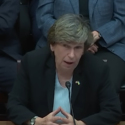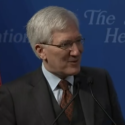After the 9/11 terrorist attack it became clear that the U.S. was not immune to acts of violence that could infiltrate the country’s heart of business and power causing massive destruction and loss of life. It also became clear that the country needed to put into place a system that would facilitate an easy succession to the presidency in the “face of a catastrophic attack that would kill or incapacitate multiple individuals in the line of succession,” according to a June 2009 report jointly released by the American Enterprise Institute (AEI) and Brookings Institution Continuity of Government Commission.
The report, titled “Presidential Succession” indicates that “the current [presidential] system would be inadequate” in the event of such an attack and further suggests that “the current system must be corrected to ensure continuity in the executive branch.”
Speaking at the report’s launch at AEI, John C. Fortier—the Commission’s committee Executive Director and a research fellow at AEI—said that “Washington will remain a key target for terrorists.” Fortier pointed out that “both the constitution and the law fail to outline an adequate succession plan.”
Frances Townsend, head of Corporate Risk Management Consulting at Baker Botts, expressed concern about “people’s [limited] attention and time to this issue,” and said that it was important to find out what the government was doing to address it. “We need to ask the current administration: ‘what are you doing about this?’” she said. Townsend urged that “there needs to be people inside the government who are devoted to this topic and constantly refining [it].”
“Presidential Succession” is the second report released by the Continuity of Government Commission. The Commission, formed in 2002 after the aftermath of 9/11, was tasked to “consider how each of the three branches of government might reconstitute themselves after a catastrophic attack on Washington D.C. and to make recommendations for statutory and constitutional changes that would improve the continuity of our basic institutions.” The first report, released in June 2003 addressed “Congress Continuity.”
The report’s recommendations include “the creation of four or five new federal offices” outside of the nation’s capital. “Given the possibility of an attack with weapons of mass destruction, it is essential that the line of Presidential succession include at least some individuals who live and work outside of the Washington, D.C. area,” states the report. According to the Commission, “the President would appoint important figures to these offices, and they would be confirmed by the Senate.”
The Commission further suggests that these figures “would largely be former high- government officials that the President felt comfortable appointing such as former presidents, former secretaries of state, former members of Congress, or even sitting governors, all located outside of Washington, D.C.
Another proposal by the Commission is the elimination of Congressional leaders from the succession line so as to avoid destabilizing the government. “Excluding Congressional leaders would eliminate the possibility that the presidency would shift to the other party if a catastrophic attack killed both the President and Vice-President. It would eliminate the possibility of a rump group of a handful of lawmakers choosing a Speaker of the House who would then become president.” The report further states that “removing Congressional leaders would improve succession during incapacitation. If the presidency must pass to a Congressional leader because of temporary incapacitation, then it would be very difficult for Congressional leaders to step in for the President.”
A third recommendation includes the special election of a president. The Commission calls upon Congress to “reform our current law to provide for a special election within five months if a simultaneous vacancy of the presidency and vice-presidency occurs in the first two years of a presidential term.” The report further states that “were such an election not to occur, the interim successor should serve until the end of the term.”
Fourthly, the report advocates for the reordering of the line of succession and recommends that “the order of succession start with the Secretary of State, followed by the Secretary of Defense, the Attorney General and the Secretary of Treasury.” Further, the Commission argues that the low profile cabinet members be replaced by the aforementioned offices created outside of the capital.
Fifthly, the Commission suggests that Congress should remove acting secretaries from the line of succession. “The current line of succession is particularly ambiguous around the inauguration when a number of departments are briefly headed by acting secretaries pending the confirmation of cabinet secretaries in the new administration,” states the report.
The Commission’s sixth proposal calls for Congress to “clarify procedures for incapacitation, especially for lower profile officials in the line of succession.” According to the report, the 25th Amendment clearly lays out guidelines for a vice-presidential take-over in case of a presidential incapacitation, but fails to address procedures for succession by lower officials.
Finally, the Commission recommends that “Congress and the political parties should take preventative measures to secure the line of succession in the very dangerous times both during and before the inauguration.”
The Commission’s committee members called for Congress support in implementing the report’s recommendations. “The first thing one has to do is to convince Congress that this is something worth investing in,” said Martin Frost, one of the commissioners. “You would think that after 9/11 you would have the attention of Congress leaders, but this has not been the case,” lamented Frost.
Emily Kanyi is an intern at the American Journalism Center, a training program run by Accuracy in Media and Accuracy in Academia.











